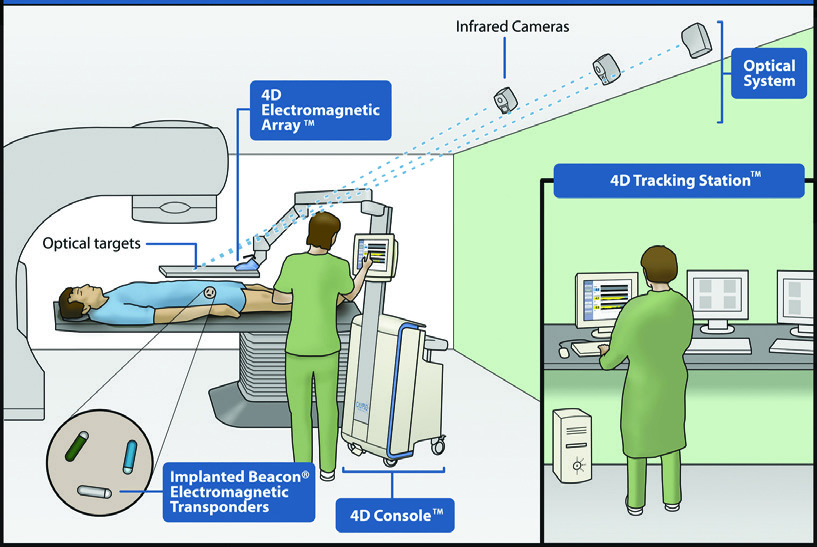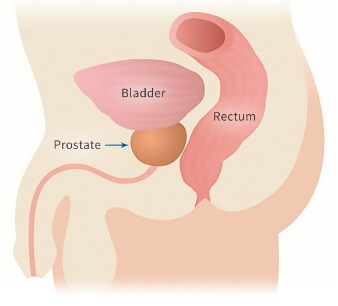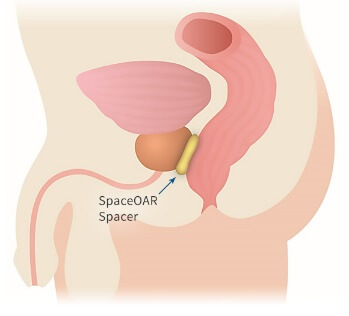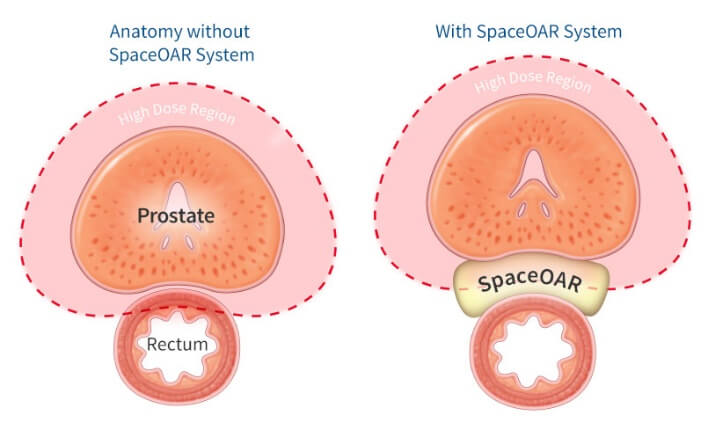Intensity Modulated Radiation Therapy (IMRT) and Image Guided Radiation Therapy (IGRT)
Uropartners Prostate Centers utilize high-performance state of the art Varian linear accelerators and Phillips and GE CT scanners for treatment planning and treatment delivery.
The Varian Linear Accelerator is one of the most advanced radiation therapy devices currently available on the market for the delivery of IMRT and IGRT radiation. Our treatment machine is fully customizable for each patient, allowing the physician and physicist to tailor the machine settings and positioning to best treat your cancer.
Utilizing IMRT the radiation therapist and physicist are able to precisely target the cancer while sparing healthy tissue nearby.
The use of IMRT allows the radiation therapist and physicist to customize and precisely target the cancer while sparing healthy tissue nearby. The radiation dose is designed to conform to the 3-dimensioonal shape of the target volume by modulating or controlling the intensity of the radiation beam.
The prostates location between the bladder and rectum means that the prostate may not be in the same position daily. IGRT allows the radiation therapists to visualize the treatment area and ensure that the radiation is accurately delivered.
Due to the proximity of the prostate between the bladder and rectum the position of the target may vary from day to day. IGRT allow the radiation oncologist and the radiation therapists to visualize the treatment area and ensure that the radiation is accurately delivered.
Intensity Modulated Radiation Therapy (IMRT) and Image Guided Radiation Therapy (IGRT)
Uropartners Prostate Centers utilize high-performance state of the art Varian linear accelerators and Phillips and GE CT scanners for treatment planning and treatment delivery.
The Varian Linear Accelerator is one of the most advanced radiation therapy devices currently available on the market for the delivery of IMRT and IGRT radiation. Our treatment machine is fully customizable for each patient, allowing the physician and physicist to tailor the machine settings and positioning to best treat your cancer.
Utilizing IMRT the radiation therapist and physicist are able to precisely target the cancer while sparing healthy tissue nearby.
The use of IMRT allows the radiation therapist and physicist to customize and precisely target the cancer while sparing healthy tissue nearby. The radiation dose is designed to conform to the 3-dimensioonal shape of the target volume by modulating or controlling the intensity of the radiation beam.
The prostates location between the bladder and rectum means that the prostate may not be in the same position daily. IGRT allows the radiation therapists to visualize the treatment area and ensure that the radiation is accurately delivered.
Due to the proximity of the prostate between the bladder and rectum the position of the target may vary from day to day. IGRT allow the radiation oncologist and the radiation therapists to visualize the treatment area and ensure that the radiation is accurately delivered.
Calypso 4D Localization System (GPS for the Prostate)
Calypso is used in conjunction with IMRT to ensure that the highly tailored treatment created by your medical team is delivered exactly where it is intended with millimeter precision. Prior to initiating the radiation treatments your physician will implant small fiducial markers (transponders) into your prostate or prostatic bed. These tiny beacons transmit a signal that is picked up by the Calypso system allowing for real time tracking of your prostate. If during treatment your prostate moves out of the intended treatment area the radiation therapists will stop your treatment and realign you ensuring that the radiation is delivered to the intended target.
Monitoring prostate organ motion during radiation therapy delivery allows for increased clinical confidence that comes with knowing the tumor target is accurately and precisely aligned with the delivery of the radiation beam during every patient treatment.

MRI Fusion Biopsies
We remain on the cutting edge of medicine, by utilizing the UroNav System along with DynaCad MRI analysis to perform MRI Fusion Prostate Biopsies. This system permits our urologists and radiation oncologists to locate and sample suspicious regions of interest within the prostate identified by the radiologist on your MRI. During the biopsy the MRI images are fused to the ultrasound images to allow real time guidance ensuring accurate diagnosis.
Brachytherapy
Brachytherapy is a radiation treatment where radioactive seeds are implanted into the prostate under general anesthesia using ultrasound guidance. Depending on the type and stage of cancer, you and the radiation oncologist may decide to combine brachytherapy with IGRT and IMRT to treat the cancer.
Depending on the type and stage of cancer, you and the radiation oncologist may decide to combine brachytherapy with IGRT and IMRT to treat the cancer.
Saturation Biopsies
Certain patients may require a more in depth sampling of their prostate due to high risk factors. A saturation biopsy takes samples from all regions of the prostate. Saturation biopsies are done transperineally requiring general anesthesia.
Hormone Therapy
Prostate cancer in men is fueled by the hormone testosterone. Hormone therapy works by denying prostate cancer the fuel need for it to grow. For appropriate patients your physician may prescribe either short or long term hormonal therapy to improve your treatment outcome.
Space OAR
Uropartners is proud to offer Space OAR® since its FDA approval in 2015.
SpaceOAR® System – Rectal Protection for Prostate Cancer Radiation Therapy Patients
UroPartners is now offering a new tool that is proven to protect prostate cancer patients from the negative effects of radiation therapy.
Because of the close proximity of the prostate to the rectum, prostate radiation therapy typically results in some radiation hitting the rectum, which can sometimes cause side effects, such as pain during bowel movements, rectal urgency, bleeding or loose stools during or after radiation treatment. That’s why the rectum is called the Organ At Risk (OAR) during prostate radiation therapy.
SpaceOAR System reduces rectal injury in men receiving prostate cancer radiation therapy by acting as a spacer – pushing the rectum away from the prostate and out of the high dose radiation region.



The hydrogel spacer is injected during a minimally invasive procedure, and — once in place — patients typically can’t feel it. The hydrogel is safe and similar to other products used in brain surgery, cardiology and ophthalmology. It remains in place for 3 months during radiation treatment, and is then absorbed and leaves the body in the patient’s urine — leaving nothing behind.
SpaceOAR System has been has been clinically proven and studied in a US Clinical Trial and is FDA cleared for sale in the US.
To learn more about SpaceOAR hydrogel please see the Frequently Asked Questions (FAQ) Patient Guide
For more information on SpaceOAR system go to http://www.spaceoar.com
Please see Instructions for Use for a complete list of potential risks, warnings and precautions.
Barrigel
UroPartners is proud to offer Barrigel.
Advanced Technology Protects Health Tissue for Men Undergoing Radiation Treatment For Prostate Cancer
What You Should Know Before Starting Treatment
Men facing a prostate cancer diagnosis often face the challenge of navigating the multitude of treatment options available to determine the right path for them. Each year, about 290,000 men are diagnosed with prostate cancer in the United States. It is the second most common cancer among U.S. men, occurring in one in eight males.
A variety of treatment options are available for prostate cancer based on prognosis. To determine which treatment is best for them, patients should work together with their doctor to weigh the advantages and disadvantages of all appropriate options. Radiation treatment, also known as radiotherapy, is the most effective form of treatment for many men with prostate cancer. Recent innovations and advanced technologies, make radiation an even stronger cornerstone of treatment. While radiation therapy often leads to successful patient outcomes, it is important to protect surrounding healthy tissue from radiation exposure. Damage to this healthy tissue can result in long-term side effects, which can impact patients’ quality of life.
Recognizing the need to offer the latest advancements in radiotherapy and best patient outcomes, prostate cancer specialists from UroPartners, are among the first in the Chicago area to use Barrigel®, an advanced technology that protects healthy tissue from radiation exposure. Barrigel is an injectable biodegradable gel that is injected between the prostate and the rectum to create therapeutic distance between the two organs, lowering the risk of toxicity to the rectum and, if desired, the seminal vesicles which produce fluid that becomes part of the semen. This technique minimizes potential unwanted side effects and complications of prostate radiotherapy.2 In the first FDA clinical study of a rectal spacer using a shortened course of radiotherapy (hypofractionated radiotherapy) 98.5% of patients showed Barrigel to be effective in achieving a significant reduction in radiation to the rectum.
This reduced unwanted side effects, including inflammation of the rectum (radiation proctitis), diarrhea, and hemorrhoids. Barrigel is made from Non-Animal Stabilized Hyaluronic Acid (NASHA®), which has been proven safe and effective, and has been used for more than 20 years in over 50 million medical procedures in men, women and children worldwide.3 A groundbreaking spacing technology, Barrigel addresses the limitations of current spacing materials by offering patient-specific customization with the ability to sculpt the spacer for personalized coverage. The result is more efficient, patient tailored results for optimal coverage.
For more information about prostate cancer treatments at UroPartners contact us at (224) 260-3100.
.
Immunotherapy
Uropartnrers Prostate Centers have offered Provenge, which is an immunotherapy treatment that helps the immune system fight prostate cancer cells, since its FDA approval in 2005. This advanced and highly personalized therapy consists of the patient’s own immune cells that have been modified to seek and attack prostate cancer cells. By stimulating the natural ability of the patients own immune cells, provenge may improve the patents overall prostate cancer prognosis.
Active Surveillance
An active surveillance approach may be a treatment option for patients with non-aggressive early stage prostate cancer. Patients are closely monitored by their urologist for changes in the progression of their cancer and their PSA is tested at regular intervals.